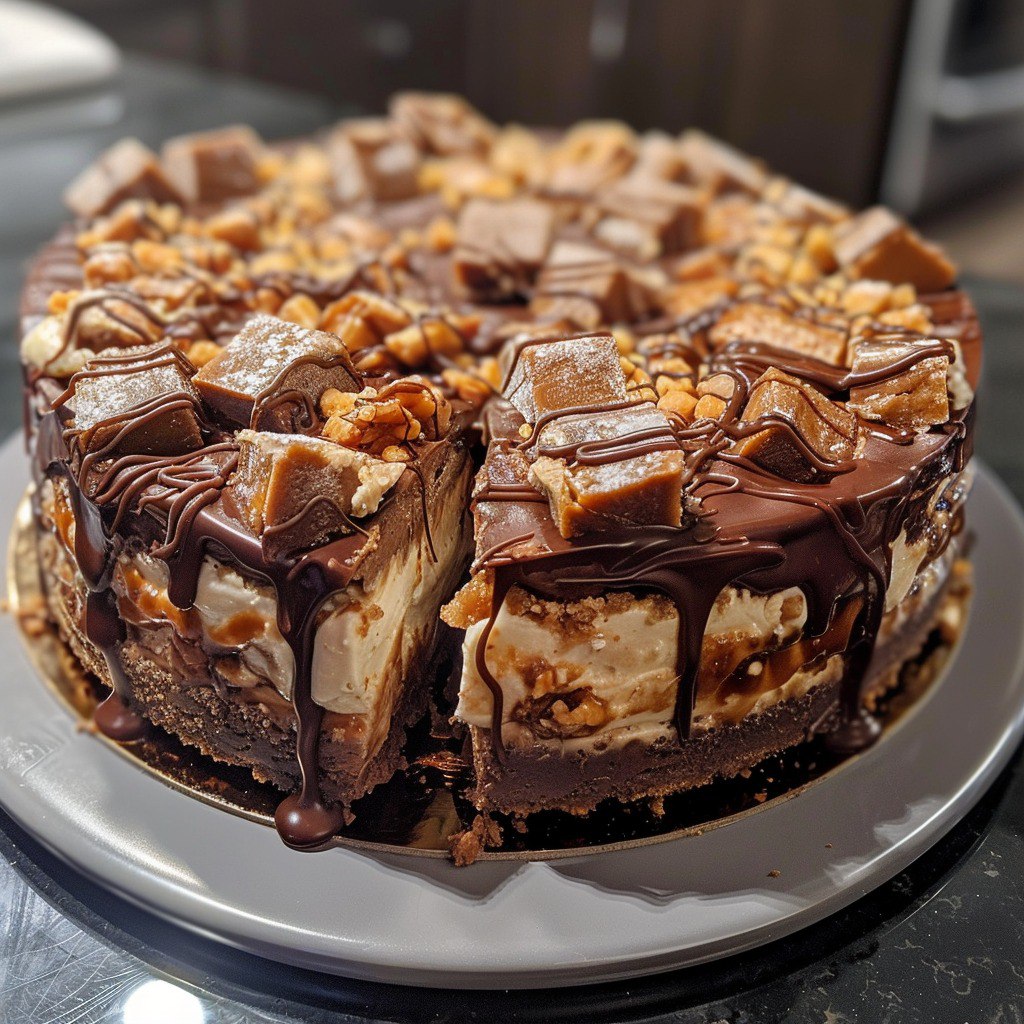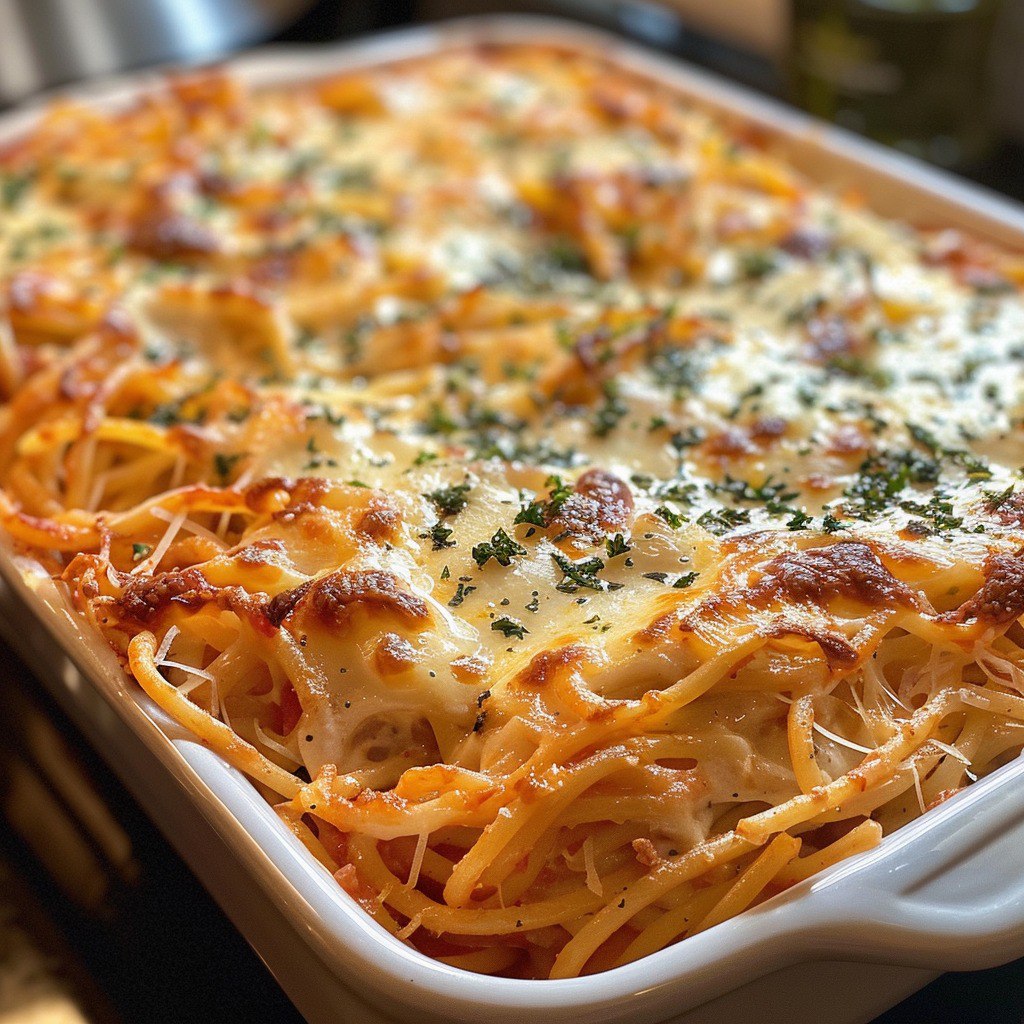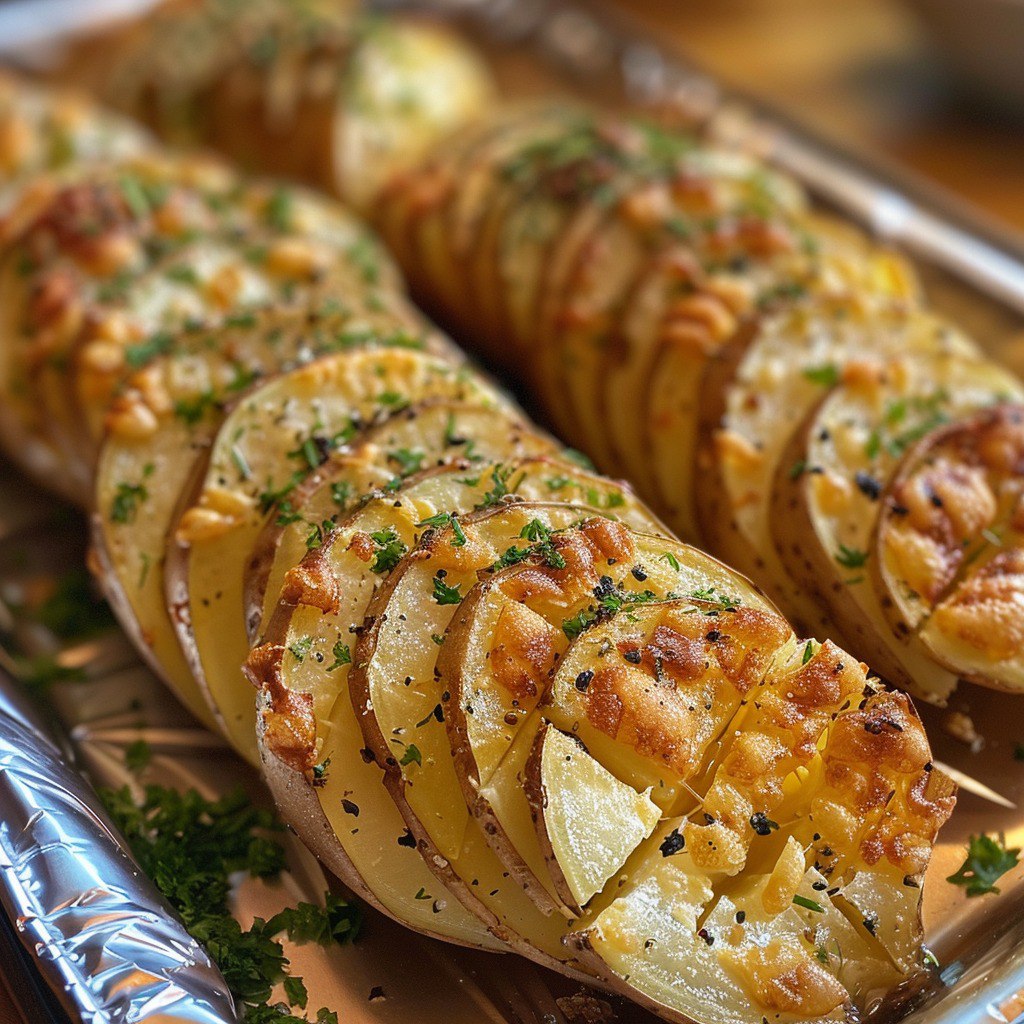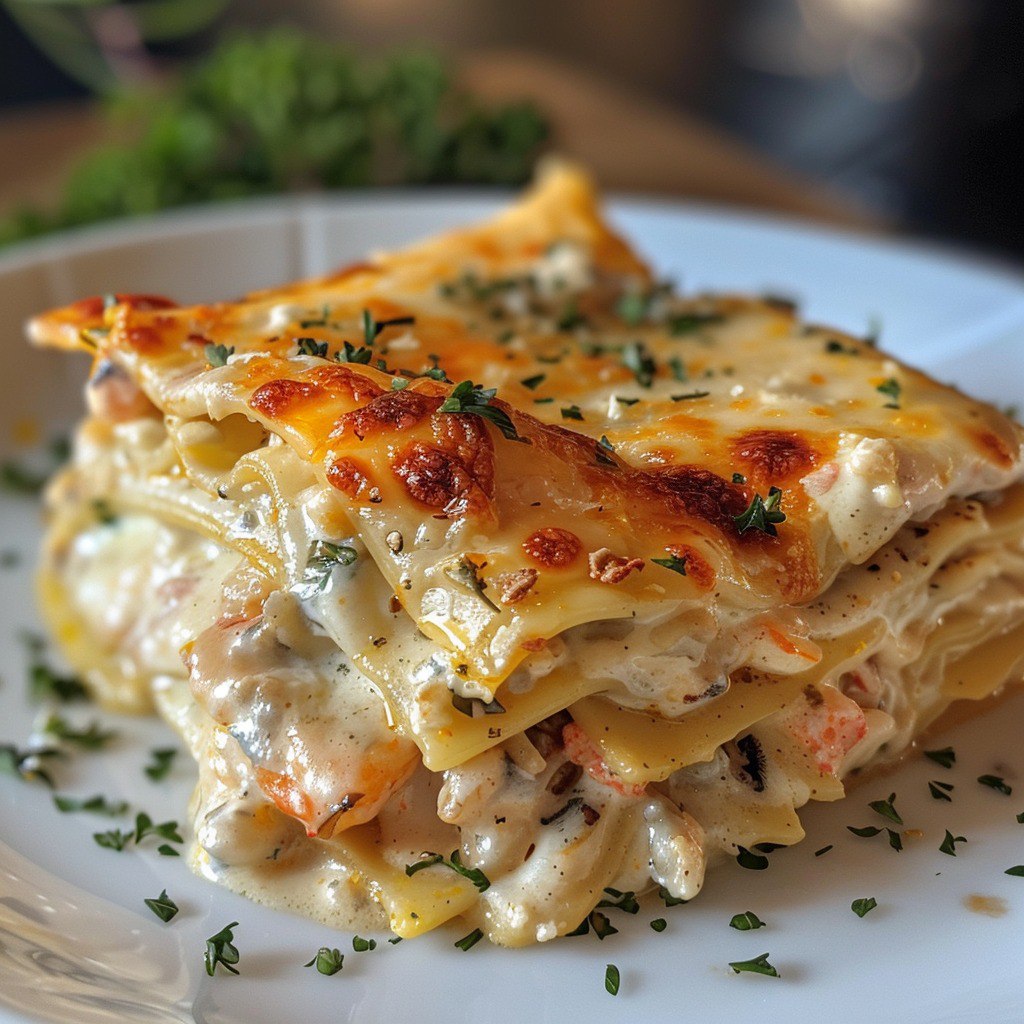Experience the epitome of comfort food with this luxurious creamy baked spaghetti with cream cheese that transforms ordinary pasta night into an extraordinary culinary adventure. This indulgent dish combines the familiar comfort of traditional spaghetti with the rich, velvety smoothness of cream cheese, creating layers of flavor that will have your family requesting this recipe again and again. Moreover, the addition of cream cheese elevates this humble pasta dish into something truly special and memorable.
Furthermore, this creamy baked spaghetti with cream cheese represents the perfect marriage of convenience and sophistication. Additionally, the make-ahead nature of this casserole makes it ideal for busy weeknights, potluck dinners, or entertaining guests. Moreover, the bubbling cheese top and aromatic herbs create an irresistible presentation that looks as amazing as it tastes.
Print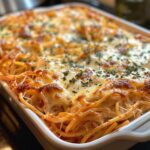
Creamy Baked Spaghetti with Cream Cheese: The Ultimate Comfort Food
- Total Time: 1 hr 10 mins
- Yield: 8 servings 1x
Description
Creamy Baked Spaghetti with Cream Cheese is the ultimate comfort food! This rich and cheesy pasta bake features tender spaghetti tossed in a luscious mixture of cream cheese, sour cream, and Parmesan, then layered with marinara and mozzarella for a melt-in-your-mouth finish. It’s easy, indulgent, and perfect for cozy family dinners or potlucks.
Ingredients
- 1 pound spaghetti noodles
- 1 (8 oz) package cream cheese, softened
- 1 cup sour cream
- 1 cup grated Parmesan cheese
- 1 (24 oz) jar marinara sauce
- 1 teaspoon garlic powder
- 1 teaspoon dried basil
- Salt and pepper, to taste
- 2 cups shredded mozzarella cheese
- Fresh parsley, for garnish
Instructions
- Preheat oven to 350°F (175°C). Grease a 9×13 inch baking dish.
- Cook spaghetti noodles according to package instructions until al dente. Drain and set aside.
- In a large bowl, mix softened cream cheese, sour cream, Parmesan cheese, garlic powder, basil, salt, and pepper until smooth.
- Add the cooked spaghetti to the mixture and toss until evenly coated.
- Spread half of the marinara sauce in the bottom of the prepared baking dish.
- Layer half of the spaghetti mixture over the sauce. Repeat with remaining sauce and spaghetti.
- Sprinkle mozzarella cheese evenly over the top.
- Cover with foil and bake for 30 minutes. Remove foil and bake for another 10–15 minutes, until cheese is bubbly and golden.
- Let rest for a few minutes before serving. Garnish with chopped parsley.
Notes
- Add cooked ground beef, Italian sausage, or shredded chicken for extra protein.
- Use whole wheat or gluten-free pasta if desired.
- Make ahead and refrigerate, then bake when ready to serve.
- Prep Time: 30 mins
- Cook Time: 40 mins
- Category: Main Dish
- Method: Bake
- Cuisine: American, Italian-Inspired
Nutrition
- Serving Size: 1 slice
- Calories: 400 kcal
- Sugar: 5 g
- Sodium: 580 mg
- Fat: 22 g
- Saturated Fat: undefined
- Unsaturated Fat: undefined
- Trans Fat: undefined
- Carbohydrates: 38 g
- Fiber: 2 g
- Protein: 14 g
- Cholesterol: 55 mg
Keywords: baked spaghetti, spaghetti with cream cheese, creamy pasta bake, easy comfort food
Why You’ll Love This Creamy Baked Spaghetti with Cream Cheese
It’s Incredibly Rich and Satisfying
The combination of cream cheese, sour cream, and multiple cheeses creates an indulgent experience unlike traditional pasta dishes. Additionally, each bite delivers creamy richness that coats your palate with luxurious satisfaction. Moreover, the protein-rich ingredients provide lasting fullness that keeps hunger at bay.
Furthermore, the layered preparation allows flavors to meld beautifully during baking. Additionally, the cream cheese creates a velvety base that binds all ingredients harmoniously. Moreover, this richness transforms simple spaghetti into a restaurant-quality dining experience.
It’s Perfect for Meal Planning
This dish actually improves in flavor after resting, making it ideal for advance preparation. Additionally, you can assemble the entire casserole a day ahead and bake when ready. Moreover, leftovers reheat beautifully and often taste even better the next day.
Furthermore, the recipe scales easily for different crowd sizes or family needs. Additionally, individual portions can be frozen for quick future meals. Moreover, this flexibility makes it perfect for busy households and meal prep enthusiasts.
It’s Crowd-Pleasing Excellence
Even the pickiest eaters love the familiar flavors enhanced with creamy richness. Additionally, kids especially enjoy the mild, comforting taste without overwhelming spices. Moreover, adults appreciate the sophisticated texture and depth of flavor.
Furthermore, this dish works equally well for casual family dinners and special occasions. Additionally, the impressive presentation makes it suitable for entertaining guests. Moreover, the universal appeal ensures everyone at the table will be satisfied.
It’s Budget-Friendly Luxury
Despite its rich, gourmet taste, this recipe uses affordable, accessible ingredients. Additionally, pasta and cheese provide excellent value for feeding multiple people. Moreover, the satisfying nature means smaller portions leave everyone feeling full.
Furthermore, basic pantry staples create this luxurious dish without specialty ingredients. Additionally, bulk cooking reduces per-serving costs significantly. Moreover, this proves that comfort food doesn’t require expensive components.
It’s Wonderfully Versatile
The base recipe accepts countless variations and additions seamlessly. Additionally, different vegetables, meats, or seasonings can transform the dish completely. Moreover, dietary modifications are easily accommodated with simple substitutions.
Furthermore, leftover ingredients from other meals work beautifully in this flexible recipe. Additionally, seasonal vegetables can be incorporated for year-round variety. Moreover, this adaptability keeps the dish interesting meal after meal.
Essential Ingredients for Perfect Creamy Baked Spaghetti with Cream Cheese
Quality Pasta Selection
Choose high-quality spaghetti noodles that hold their shape during extended baking. Additionally, the pasta should be cooked just to al dente since it continues cooking in the oven. Moreover, slightly undercooked pasta prevents mushiness in the final dish.
Furthermore, whole wheat spaghetti adds nutritional value and nutty flavor if preferred. Additionally, the pasta’s surface texture helps the cream sauce adhere better. Moreover, proper pasta cooking is crucial for achieving ideal texture.
Premium Cream Cheese Foundation
Full-fat cream cheese provides the richest, smoothest texture for this recipe. Additionally, ensure the cream cheese is completely softened before mixing to prevent lumps. Moreover, Philadelphia or similar high-quality brands produce the best results.
Furthermore, never substitute low-fat cream cheese as it doesn’t melt or blend properly. Additionally, room temperature cream cheese incorporates much more easily. Moreover, quality cream cheese makes a noticeable difference in final flavor and texture.
Perfect Dairy Combinations
Full-fat sour cream adds tangy richness that balances the cream cheese’s density. Additionally, the acidity helps tenderize the pasta while adding complex flavor. Moreover, Greek yogurt can substitute for slightly different taste profiles.
Furthermore, freshly grated Parmesan cheese provides sharp, nutty notes that enhance overall complexity. Additionally, avoid pre-grated cheese which doesn’t melt as smoothly. Moreover, authentic Parmigiano-Reggiano elevates the dish significantly.
Quality Sauce and Seasonings
Choose a high-quality marinara sauce with balanced acidity and herb flavors. Additionally, the sauce should complement rather than overpower the creamy elements. Moreover, some brands work better than others for baked dishes.
Furthermore, fresh garlic provides more complex flavor than garlic powder when available. Additionally, dried herbs work well but fresh herbs can be substituted with quantity adjustments. Moreover, quality seasonings make ordinary ingredients extraordinary.
Step-by-Step Guide to Making Creamy Baked Spaghetti with Cream Cheese
Step 1: Preparation and Setup
Begin by preheating your oven to 350°F (175°C) for optimal baking temperature. Additionally, this moderate heat ensures even cooking without burning the cheese topping. Moreover, consistent temperature is crucial for proper melting and bubbling.
Grease a 9×13 inch baking dish thoroughly with butter or cooking spray. Furthermore, proper greasing prevents sticking and makes serving much easier. Additionally, choose a dish with adequate depth to accommodate all layers.
Remove cream cheese from refrigeration 30-60 minutes before cooking to soften properly. Additionally, softened cream cheese blends much more easily without lumps. Moreover, room temperature ingredients combine more uniformly.
Gather all remaining ingredients and measure them accurately for smooth preparation. Furthermore, having everything ready streamlines the assembly process. Additionally, organized preparation prevents rushing and potential mistakes.
Step 2: Perfect Pasta Cooking
Bring a large pot of well-salted water to a rolling boil. Additionally, use plenty of water to prevent noodles from sticking together. Moreover, salt the water generously as this seasons the pasta from within.
Add spaghetti noodles gradually to maintain water temperature. Furthermore, stir gently during the first few minutes to prevent clumping. Additionally, follow package directions but test for doneness slightly early.
Cook pasta just until al dente, maintaining a slight bite since it continues cooking during baking. Additionally, overcooked pasta becomes mushy in the finished dish. Moreover, proper texture is essential for excellent results.
Drain the pasta immediately but don’t rinse unless specified. Furthermore, reserve a cup of pasta water in case the mixture needs thinning. Additionally, hot pasta helps melt the cream cheese mixture more easily.
Step 3: Cream Cheese Mixture Creation
In a large mixing bowl, combine softened cream cheese with sour cream. Additionally, use an electric mixer or whisk vigorously to eliminate all lumps. Moreover, smooth texture is crucial for even distribution throughout the pasta.
Add grated Parmesan cheese, garlic powder, and dried basil to the cream mixture. Furthermore, mix thoroughly to distribute seasonings evenly. Additionally, taste and adjust seasonings as needed for personal preferences.
Season with salt and pepper, remembering that the pasta and sauce will also contribute flavors. Additionally, start conservatively as you can always add more later. Moreover, well-balanced seasoning enhances all other flavors.
Continue mixing until the mixture is completely smooth and well-combined. Furthermore, any lumps will be noticeable in the final dish. Additionally, this base should be creamy and spreadable.
Step 4: Pasta and Sauce Integration
Add the hot, drained spaghetti to the cream cheese mixture while still warm. Additionally, the pasta’s heat helps soften and distribute the cream mixture. Moreover, work quickly while the pasta is still hot for best results.
Toss the pasta and cream mixture thoroughly using tongs or large spoons. Furthermore, ensure every strand of spaghetti is coated with the creamy mixture. Additionally, proper coating ensures even flavor distribution.
If the mixture seems too thick, add small amounts of reserved pasta water gradually. Additionally, the mixture should coat the pasta without being too thick or too thin. Moreover, proper consistency ensures optimal baking results.
Let the mixture rest briefly while you prepare the baking dish layers. Furthermore, this allows flavors to begin melding together. Additionally, the pasta will absorb some of the cream mixture during this time.
Step 5: Strategic Layering Process
Spread exactly half of the marinara sauce evenly across the bottom of the prepared baking dish. Additionally, this base layer prevents sticking and adds moisture. Moreover, even distribution ensures consistent flavor throughout.
Layer half of the creamy spaghetti mixture over the sauce, spreading evenly. Furthermore, use a large spoon or spatula to distribute without compacting. Additionally, gentle handling maintains the pasta’s texture.
Repeat with remaining marinara sauce, spreading evenly over the pasta layer. Additionally, ensure complete coverage to prevent exposed pasta from drying out. Moreover, sauce layers provide necessary moisture during baking.
Top with the remaining spaghetti mixture, again spreading evenly. Furthermore, the final layer should be relatively smooth for attractive presentation. Additionally, proper layering creates beautiful cross-sections when served.
Step 6: Final Assembly and Baking
Sprinkle shredded mozzarella cheese evenly over the entire top surface. Additionally, generous cheese coverage creates the appealing golden-brown finish. Moreover, the melted cheese seals in moisture and flavors.
Cover the baking dish tightly with aluminum foil to prevent over-browning. Furthermore, create a slight tent to prevent foil from touching the cheese. Additionally, covered baking ensures even heating throughout.
Bake for 30 minutes covered, then remove foil and continue baking 10-15 minutes. Additionally, watch for bubbling edges and golden cheese color. Moreover, the uncovered time creates the appealing browned top.
Test doneness by checking that the center is hot and cheese is melted throughout. Furthermore, a knife inserted in center should come out hot. Additionally, bubbling around edges indicates proper heating.
Let the casserole rest for 5-10 minutes before serving to allow layers to set. Moreover, hot casserole will be too loose to slice cleanly initially. Additionally, resting time makes serving much easier and neater.
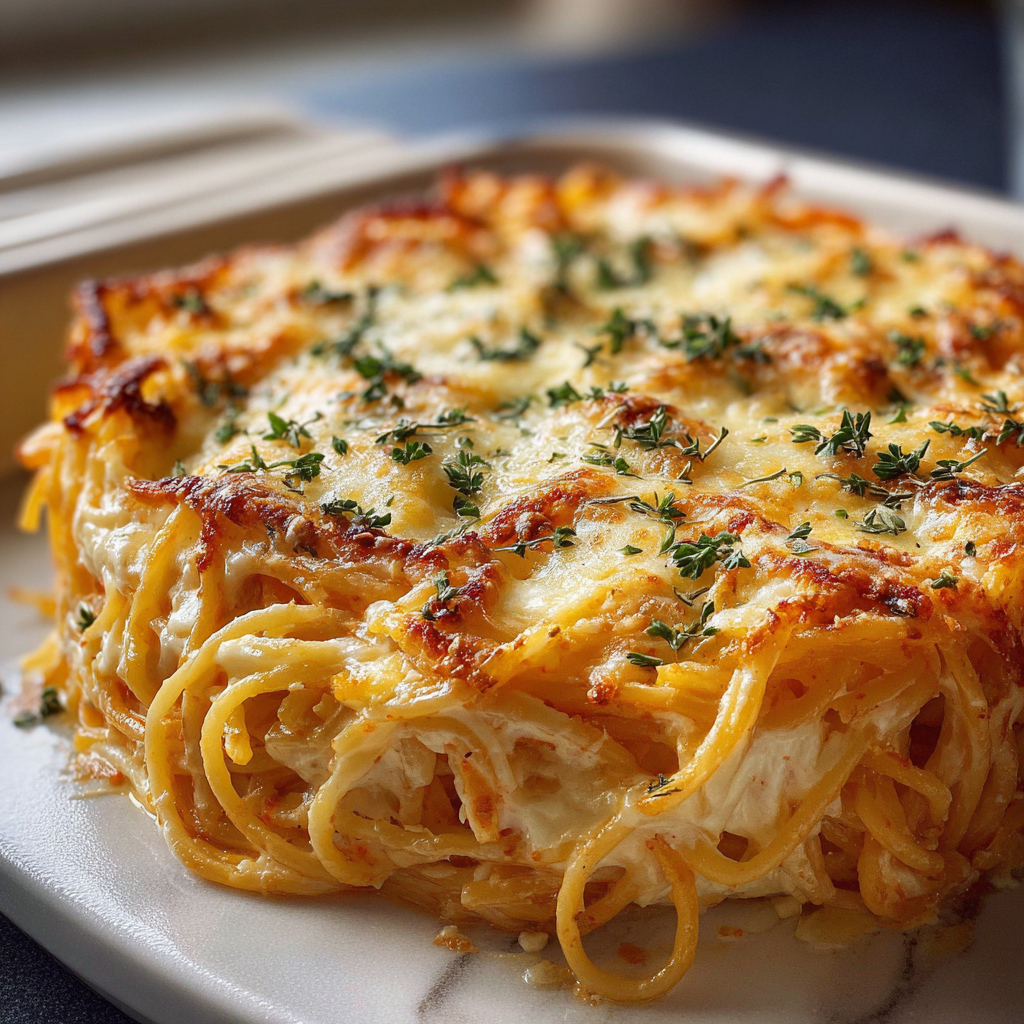
Pro Tips for the Best Creamy Baked Spaghetti with Cream Cheese
Cream Cheese Handling Excellence
Always use full-fat cream cheese at room temperature for optimal blending. Additionally, microwave cold cream cheese briefly if you forget to soften it ahead. Moreover, properly softened cream cheese eliminates lumps completely.
Furthermore, add cream cheese to other dairy ingredients gradually while mixing. Additionally, this prevents overwhelming the mixture and ensures smooth integration. Moreover, patience during this step prevents texture problems.
Pasta Cooking Optimization
Slightly undercook pasta since it continues cooking during the long baking time. Additionally, reserve pasta cooking water to adjust mixture consistency if needed. Moreover, properly cooked pasta maintains better texture in baked dishes.
Furthermore, don’t rinse pasta after draining unless the recipe specifically calls for it. Additionally, the starch on pasta helps sauces adhere better. Moreover, hot pasta helps melt and distribute the cream cheese mixture.
Layering Strategy
Ensure even distribution of all layers for consistent flavor in every bite. Additionally, use measuring cups to divide ingredients evenly between layers. Moreover, systematic layering creates better final appearance and taste.
Furthermore, don’t compact layers too firmly as this prevents even heating. Additionally, gentle spreading maintains pasta texture while ensuring coverage. Moreover, proper layering techniques create professional-looking results.
Baking Technique Mastery
Cover tightly during initial baking to create steam that heats the center thoroughly. Additionally, remove foil gradually to prevent sudden temperature changes. Moreover, proper covering prevents over-browning while ensuring complete heating.
Furthermore, check for doneness in multiple spots since casseroles can heat unevenly. Additionally, bubbling around edges usually indicates proper internal temperature. Moreover, visual cues help determine perfect doneness.
Creative Variations for Your Creamy Baked Spaghetti with Cream Cheese
Protein Additions
Brown ground beef or Italian sausage and layer between the pasta and sauce. Additionally, seasoned ground turkey provides a leaner protein option. Moreover, pre-cooked proteins integrate easily without affecting cooking times.
Furthermore, leftover rotisserie chicken works beautifully when shredded and distributed throughout. Additionally, bacon bits add smoky richness that complements the creamy base. Moreover, multiple proteins can be combined for complex flavors.
Vegetable Enhancements
Sautéed mushrooms add earthy depth and meaty texture to the dish. Additionally, bell peppers provide sweetness and colorful visual appeal. Moreover, vegetables should be pre-cooked to prevent excess moisture.
Furthermore, spinach wilts beautifully into the cream mixture without affecting texture. Additionally, sun-dried tomatoes contribute intense flavor and Mediterranean flair. Moreover, seasonal vegetables keep the dish interesting year-round.
Herb and Spice Modifications
Fresh basil provides more vibrant flavor than dried when available. Additionally, oregano and Italian seasoning blend well with the existing flavors. Moreover, fresh herbs should be added just before serving.
Furthermore, red pepper flakes add gentle heat without overwhelming mild flavors. Additionally, garlic can be increased for more robust taste. Moreover, spice levels can be adjusted to suit family preferences.
Cheese Combinations
Substitute part of the mozzarella with provolone for sharper flavor. Additionally, Romano cheese provides more intense taste than Parmesan. Moreover, different cheese combinations create unique flavor profiles.
Furthermore, cream cheese can be partially replaced with mascarpone for ultra-rich results. Additionally, ricotta cheese adds different texture and mild flavor. Moreover, experimenting with cheese creates personalized versions.
Common Mistakes to Avoid When Making Creamy Baked Spaghetti with Cream Cheese
Cream Cheese Temperature Issues
Using cold cream cheese creates lumps that don’t dissolve during mixing or baking. Additionally, these lumps create uneven texture throughout the finished dish. Moreover, proper softening is essential for smooth results.
Furthermore, overheating cream cheese can cause it to separate and become grainy. Additionally, gentle mixing at room temperature produces the best texture. Moreover, patience during preparation prevents texture problems.
Pasta Overcooking Problems
Cooking pasta beyond al dente results in mushy texture after baking. Additionally, pasta continues cooking in the hot oven environment. Moreover, slightly firm pasta maintains better structure in casseroles.
Furthermore, not draining pasta thoroughly adds excess water that thins the sauce. Additionally, wet pasta doesn’t hold seasonings or cream mixture effectively. Moreover, proper draining is crucial for optimal consistency.
Layering and Assembly Errors
Uneven layer distribution creates inconsistent flavors and textures throughout the dish. Additionally, some portions may be too saucy while others are too dry. Moreover, systematic layering ensures uniform results.
Furthermore, compacting layers too firmly prevents even heating and creates dense texture. Additionally, gentle spreading maintains pasta integrity while ensuring coverage. Moreover, proper technique creates better final results.
Baking Temperature and Timing Issues
Baking at too high temperature browns the top before the center heats through. Additionally, this creates uneven cooking and potentially burnt cheese. Moreover, moderate temperature ensures thorough, even heating.
Furthermore, not covering during initial baking allows moisture to escape too quickly. Additionally, this can dry out the top layer and prevent proper melting. Moreover, proper covering technique maintains optimal moisture levels.
Perfect Side Dishes for Creamy Baked Spaghetti with Cream Cheese
Fresh Salad Accompaniments
A crisp Caesar salad provides refreshing contrast to the rich, creamy pasta. Additionally, the tangy dressing cuts through the heaviness beautifully. Moreover, crunchy romaine lettuce adds textural variety to the meal.
Furthermore, mixed greens with balsamic vinaigrette offer bright, acidic balance. Additionally, fresh vegetables provide essential nutrients and fiber. Moreover, light salads prevent the meal from feeling too heavy.
Bread and Garlic Options
Warm garlic bread complements the Italian flavors while providing satisfying carbohydrates. Additionally, crusty bread helps diners enjoy every drop of creamy sauce. Moreover, homemade garlic bread elevates the entire dining experience.
Furthermore, breadsticks or dinner rolls work well for more casual presentations. Additionally, herb-seasoned breads enhance the overall flavor profile. Moreover, bread options help round out the meal satisfyingly.
Vegetable Side Dishes
Roasted broccoli or green beans add color and nutrition to balance the rich pasta. Additionally, slightly crisp vegetables provide textural contrast. Moreover, simple preparations don’t compete with the complex main dish.
Furthermore, sautéed spinach with garlic echoes Italian flavors while adding nutrients. Additionally, asparagus spears create elegant presentations for special occasions. Moreover, green vegetables balance the visual appeal of the white and red pasta dish.
Storage and Reheating Tips for Creamy Baked Spaghetti with Cream Cheese
Proper Storage Methods
Store leftover casserole in airtight containers in the refrigerator for up to four days. Additionally, cool completely before refrigerating to prevent condensation. Moreover, proper storage maintains food safety and quality.
Furthermore, divide large portions into smaller containers for easier reheating and portion control. Additionally, individual servings reheat more evenly than large amounts. Moreover, this prevents repeated heating of the entire dish.
Reheating Techniques
Reheat individual portions in the microwave using 50% power for even warming. Additionally, cover with microwave-safe plastic wrap to retain moisture. Moreover, lower power prevents overcooking the cream cheese components.
Furthermore, oven reheating at 325°F works well for larger portions. Additionally, cover with foil and add a tablespoon of water to create steam. Moreover, gentle reheating preserves the creamy texture better.
Freezing and Thawing
This casserole freezes well for up to three months when properly wrapped. Additionally, cool completely before freezing to prevent ice crystal formation. Moreover, proper packaging prevents freezer burn and flavor loss.
Furthermore, thaw frozen casserole overnight in the refrigerator before reheating. Additionally, never thaw at room temperature due to food safety concerns. Moreover, thawed casserole may need slightly longer reheating time.
FAQs About Creamy Baked Spaghetti with Cream Cheese
Q: Can I make this creamy baked spaghetti with cream cheese ahead of time?
A: Yes! This dish is perfect for advance preparation. Additionally, you can assemble the entire casserole up to 24 hours before baking. Moreover, cover tightly and refrigerate until ready to cook.
Furthermore, assembled casseroles may need an extra 10-15 minutes of baking time when starting cold. Additionally, let it come to room temperature for 30 minutes before baking if possible. Moreover, make-ahead preparation actually improves the flavors.
Q: What can I substitute for cream cheese in this recipe?
A: While cream cheese is essential for the signature texture, some alternatives exist. Additionally, mascarpone cheese provides similar richness with slightly different flavor. Moreover, a combination of ricotta and butter can approximate the texture.
Furthermore, Neufchâtel cheese offers similar results with slightly less fat. Additionally, avoid low-fat alternatives as they don’t melt or blend properly. Moreover, the cream cheese is crucial for this recipe’s unique character.
Q: How do I prevent the cream cheese mixture from becoming lumpy?
A: Room temperature cream cheese is absolutely essential for smooth mixing. Additionally, use an electric mixer or food processor for best results. Moreover, add other ingredients gradually while mixing continuously.
Furthermore, if lumps form, strain the mixture through a fine-mesh sieve. Additionally, warming the mixture slightly can help dissolve stubborn lumps. Moreover, patience during mixing prevents most texture problems.
Q: Can I add vegetables to this creamy baked spaghetti with cream cheese?
A: Absolutely! Many vegetables work beautifully in this versatile dish. Additionally, sauté vegetables first to remove excess moisture and concentrate flavors. Moreover, pre-cooking prevents vegetables from making the dish watery.
Furthermore, spinach, mushrooms, and bell peppers are particularly popular additions. Additionally, frozen vegetables should be thawed and drained thoroughly. Moreover, vegetables add nutrition and color to the rich dish.
Q: Why is my baked spaghetti watery after cooking?
A: Excess moisture usually comes from inadequately drained pasta or vegetables. Additionally, using low-fat dairy products can contribute to watery texture. Moreover, not covering properly during baking can also affect consistency.
Furthermore, ensure pasta is well-drained and vegetables are pre-cooked. Additionally, let the casserole rest after baking to allow layers to set. Moreover, proper ingredient preparation prevents most moisture issues.
Q: How can I make this dish healthier without losing the creamy texture?
A: Several modifications can reduce calories while maintaining satisfying texture. Additionally, use part-skim mozzarella and reduce the amount slightly. Moreover, Greek yogurt can replace some of the sour cream.
Furthermore, add extra vegetables to increase nutrition and fiber content. Additionally, use whole wheat pasta for additional nutrients. Moreover, smaller portions with large salads create satisfying, balanced meals.
Nutritional Benefits of Creamy Baked Spaghetti with Cream Cheese
Protein and Calcium Content
The multiple dairy products provide substantial protein and calcium for bone health. Additionally, cream cheese and other cheeses contribute complete proteins. Moreover, adequate calcium supports both bone strength and muscle function.
Furthermore, the protein content helps maintain satiety and stable blood sugar levels. Additionally, dairy proteins are easily absorbed and utilized by the body. Moreover, this makes the dish satisfying and nutritionally valuable.
Complex Carbohydrate Energy
Pasta provides sustained energy through complex carbohydrates that digest slowly. Additionally, this prevents blood sugar spikes associated with simple sugars. Moreover, complex carbs fuel both physical and mental activities effectively.
Furthermore, the fiber content in pasta supports digestive health. Additionally, whole wheat pasta increases fiber and nutrient content significantly. Moreover, carbohydrates are essential for optimal brain function.
Vitamin and Mineral Contributions
Dairy products provide essential B-vitamins for energy metabolism and nerve function. Additionally, vitamin A supports immune function and eye health. Moreover, these nutrients are often deficient in modern diets.
Furthermore, marinara sauce contributes lycopene and vitamin C from tomatoes. Additionally, herbs provide antioxidants and various micronutrients. Moreover, the combination creates a nutritionally diverse dish.
Balanced Macronutrient Profile
This dish provides excellent balance of proteins, carbohydrates, and fats for satisfaction. Additionally, the fat content helps with vitamin absorption and satiety. Moreover, balanced meals support stable energy levels.
Furthermore, the rich texture promotes mindful eating and portion awareness. Additionally, satisfying meals prevent overeating and unhealthy snacking. Moreover, comfort foods can be part of balanced nutrition when enjoyed mindfully.
Conclusion
This extraordinary creamy baked spaghetti with cream cheese elevates humble pasta night into a luxurious dining experience that satisfies both body and soul. Additionally, the rich, velvety texture and complex flavors create memories that bring families together around the dinner table. Moreover, this recipe proves that comfort food can be both indulgent and achievable for home cooks of all skill levels.

